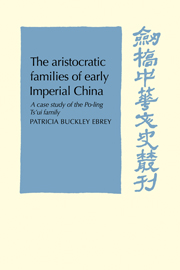Book contents
- Frontmatter
- Contents
- List of tables
- Acknowledgements
- Chronology of the Chinese dynasties
- 1 Introduction
- 2 The historical development of the aristocratic families
- 3 Origins of the Ts'uis in the Han
- 4 The Ts'uis in the aristocratic age
- 5 The Ts'uis as an old family in the T'ang
- 6 Implications and conclusions
- Notes to the text
- Appendix I The reliability of the genealogical tables in the Hsin T'ang shu
- Appendix II Annotated genealogy of the descendants of Ts'ui Yen, d. 646
- Appendix III Marriages of Po-ling Ts'uis during the T'ang
- Bibliography
- Glossary
- Index
6 - Implications and conclusions
Published online by Cambridge University Press: 04 August 2010
- Frontmatter
- Contents
- List of tables
- Acknowledgements
- Chronology of the Chinese dynasties
- 1 Introduction
- 2 The historical development of the aristocratic families
- 3 Origins of the Ts'uis in the Han
- 4 The Ts'uis in the aristocratic age
- 5 The Ts'uis as an old family in the T'ang
- 6 Implications and conclusions
- Notes to the text
- Appendix I The reliability of the genealogical tables in the Hsin T'ang shu
- Appendix II Annotated genealogy of the descendants of Ts'ui Yen, d. 646
- Appendix III Marriages of Po-ling Ts'uis during the T'ang
- Bibliography
- Glossary
- Index
Summary
This book has examined the basic characteristics of the group of people called Po-ling Ts'uis over a period of a thousand years. Its major goal has been to delineate as concretely as possible one of the aristocratic families in order to place study of these families on a more empirical basis. Most of the observations in the preceding three chapters refer specifically to the Ts'uis. Yet the Ts'uis' experiences bear on many aspects of the social system of the time, and what has been learned about them has implications for our understanding of aristocracy in early imperial China.
The most basic lesson learned from the Ts'uis is that the constancy of the terms used to describe the aristocratic families belies considerable and almost constant change. This is particularly true in the case of their nature as kinship units. The same terms for kin groups, tsung, hsing, tsu, shih, were used in all periods. Yet the reality behind these terms, and behind the term ‘the Po-ling Ts'uis’, varied greatly: in the Han the Ts'uis were a loose grouping of local kin, in the late Northern Wei a closely defined aristocratic lineage, in the T'ang a scattered group of high status families of common patrilineal descent. Thus, for the pre-Sung period, scholars should avoid making sociological inferences from these actually very loose terms, perhaps reading them as ‘kin’ rather than clan or lineage. To analyze the structure of these families, evidence of size, location, and organization must be sought.
- Type
- Chapter
- Information
- The Aristocratic Families in Early Imperial ChinaA Case Study of the Po-Ling Ts'ui Family, pp. 116 - 119Publisher: Cambridge University PressPrint publication year: 1978

